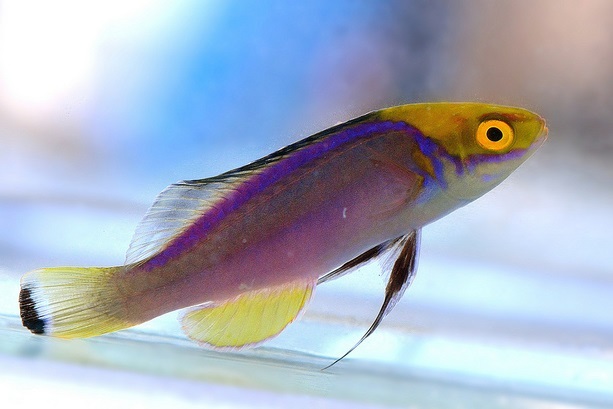Cirrhilabrus claire

| Latin name | Cirrhilabrus claire - Randall & Pyle, 2001 |
|---|---|
| Family | Labridae - Cirrhilabrus |
| Origin | Central/West Pacific |
| Max length | 8 cm (3.1") |
| Minimum volume |
300 l (79 gal) |
|---|---|
| Hardiness |
Average |
| Suitable for aquarium |
Suitable for most aquarium |
| Reef safe |
Always reef safe |
| Aggressiveness | Might be aggressive |
| Recommended |
Small crustaceans (Krill, mysis, artemia...) Zooplankton (Cyclops, pods...) |
|---|
This species is known to jump out of open aquaria.
There is little available knowledge of this species, so there can be important information missing on this page.
This species must be fed with an appropriately varied diet.
This species is very sensitive during transportation and acclimatizing into the aquarium.
Out in wild this species is used to faint light, so to acclimitize it, it is advantageous to dim the light at first and gradually increase it to normal.
This fish requires feeding several times a day, especially when newly added.
When the fish can find its natural food in the aquarium it requires less frequent feeding.
This species can change gender from male to female and vice versa.
This species needs good hiding places, for example, between live rocks.
This species revels in swimming and requires an aquarium with ample space.
This species comes in multiple color variations which can make identification problematic.
This species functions best as a pair (one male, one female), or one male with several females.
This species is very shy and docile, so one should be careful when keeping it with more aggressive fish.
This species can be aggressive when kept together with fish that are very similar, or if they are not provided with adequate space.
Fish in the genus Cirrhilabrus are very colourful and most of them are well suited to aquarium life.
They are for the most part very peaceful, but in some cases can be aggressive to closely related species. Add the largest males last, if one wants to keep multiple species together. The tank should be at least 100 gal (400 liters), but preferably 200 gal (800 liters) or more.
There is a little difference in how bold they are, some will be in the water column shortly after their introduction, whereas others need peace and quiet when first added.
As their normal reaction to being hunted or chased is to swim straight upwards there needs to be a lid on the aquarium and a secure overflow. One should therefore avoid keeping these fish with species that hunt them to avoid injury when they hit the cover.
Males can be rough with each other, but one male and several females go well together. It is best to introduce them simultaneously, or alternatively the females first. One needs a lot of space for a larger group.
There is often a large colour variation, depending on their origin and there can be a big difference between male and female. They can also change gender both from male to female and vice versa.
Males can change and flash their colours during courtship.
Fairy Wrasses like some Parrotfish, sleep between rocks in a cocoon of mucus.
They eat for the most part frozen- and flake foods of appropriate size and if their colour is to be kept, need a varied and high quality diet. Since they are very active they need feeding at least twice daily.
When these fish are chosen in the fish store, pay close attention to the mouth area as this can be injured during transport, which can lead to infection. It is also worth checking that they are active when feeding, especially in regard to large individuals.
Wrasses are nearly always seen in reef aquaria, since many of the species are both attractive and useful in battling a range of unwanted invertebrates like i.e. flatworms, pyramide snails.
These fish live of everything from zooplankton to large crustaceans, sea urchins and the like.
The needs and behaviour of Wrasses vary greatly, so it is vital to familiarize oneself with the specific species before buying one.
| Aquarium trade | No |
|---|---|
| Distribution | Eastern Central Pacific: known only from off Rarotonga, Cook Islands. |
Henry C. Schultz. 2003. The Fairy Wrasses: Cirrhilabrus spp. - Reefkeeping Magazine - (English)
Phillip Hunt. 2010. Cirrhilabrus: The Fairy Wrasses - Tropical Fish Hobbyist Magazine - (English)
Bob Fenner. Fairy or Velvet Wrasses, the Genus Cirrhilabrus, pt. 1 - Wet Web Media - (English)
Bob Fenner. Fairy or Velvet Wrasses, the Genus Cirrhilabrus, pt. 2 - Wet Web Media - (English)
Tony Vargas. 2011. Aquarium Fish: Spawning Cirrhilabrus jordani - Advanced Aquarist - (English)
Scott W. Michael. 2009. Wrasses and Parrotfishes (Reef Fishes Series Book 5) - TFH Publications / Microcosm Ltd. - (English)

